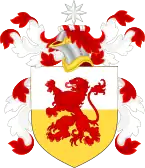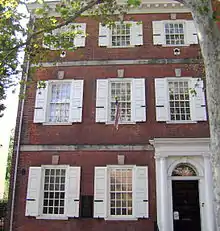Samuel Powel | |
|---|---|
_by_Angelica_Kauffman%252C_painted_c._1764%E2%80%931765.jpg.webp) | |
| Born | October 28, 1738 |
| Died | September 29, 1793 (aged 54) |
| Resting place | Christ Church Burial Ground, Philadelphia, Pennsylvania |
| Spouse | |

Samuel Powel (October 28, 1738 – September 29, 1793) was a colonial and post-revolutionary mayor of Philadelphia, Pennsylvania. Since Philadelphia's mayoral office had been abolished early in the revolutionary period, Powel was the last colonial mayor of the city and the first to serve after the United States gained independence from Great Britain.
He was born in Philadelphia, Pennsylvania, and graduated in 1759 from the College of Philadelphia (now the University of Pennsylvania). Sometime after graduation Powel made a six-year tour of Europe with his friend John Morgan, where they spent much of their time studying art treasures.[1] This customary "Grand Tour" served as an educational rite of passage. A regular feature of aristocratic education, it served as a means of gaining both exposure and association with the sophistication of Europe. He served as mayor from 1775 to 1776 and 1789 to 1790, the office having been abolished under the Pennsylvania Constitution of 1776.[2] He was a member of the Pennsylvania State Senate from 1790 to his death in 1793.[3]
Powel was an early member of the American Philosophical Society and a trustee of the College of Philadelphia (now the University of Pennsylvania).
Personal life
Powel was the son of Samuel Powel and Mary Morris.[4] On August 7, 1769, he married Elizabeth Willing, the daughter of Philadelphia mayor Charles Willing and Ann Shippen, and a sister of Philadelphia mayor and Continental Congressman Thomas Willing, a business partner of Robert Morris.
Powel died in the yellow fever epidemic of 1793 on September 29, 1793, in the bare little upper room of a tenant farmer on Powel's farm west of the city, now the site of the Powelton Village section of West Philadelphia.[5] He is interred at Christ Church Burial Ground.
Powel House
Samuel Powel's house, at 244 South 3rd Street, is a house museum run by the Philadelphia Society for the Preservation of Landmarks. A Georgian city house built by Charles Stedman in 1765, Powel expanded and embellished it around 1770, with carved woodwork and ornate plaster ceilings.
George and Martha Washington were friends of the Powels, and lived next door from November 1781 to March 1782, following the Battle of Yorktown. At the close of Washington's presidency, Mrs. Powel bought some of the furniture from the President's House in Philadelphia. The house museum owns a set of china that was a gift from Martha Washington.
The rear parlor was removed from the house in 1921, and is now at the Metropolitan Museum of Art.[6] The ballroom was removed from the house in 1925, and is now at the Philadelphia Museum of Art. Both rooms have been replicated at the house museum.[7]
Ancestry
| Ancestors of Samuel Powel[8] | |||||||||||||||||||||||||||||||||||||||||||||||||||||||||||||||||||||||||||||||||||||||||||||||||||||||||||||||||||||||||||||||||||||||||||||||||||||||||||||||||||||||||||||||||||||||||||||||||||||||||||||||||||||||||||||||||||||||||||||||||||||||||||||||||||||||||||||||||||||||||||||||||||||||||||||||||||||||||||||||||||||||||||||||||||||||||||||||||||||||||||||||||||||||||||||||||||||||||||||||||||||||||||||||||||||||||||||||||||||||||||||||||||||||||||||||||||||||||||||||||||||||||||||||||||||||||||||||||||||||||||||||||||||||||||||||||||||||||||||||||||||||||||||||||||||||||||||||||||||||||||||||||||||||||||||||||||||||||||||||||||||||||||||||||||||||||||||||||||||||||||||||||||||||||||||||||||||||||||||||||||||||||||||||||||||||||||||||||||||||||||||||||||||||||||||||||||||||||||||||||||||||||||||||||||||||||||||||||||||||||||||||||||||||||||||||||||||||||||||||||||||||||||||||||||||||||||||||||||||||||||||||||||||||||||||||||||||||||||||||||||||||||||||||||||||||||||||||||||||||
|---|---|---|---|---|---|---|---|---|---|---|---|---|---|---|---|---|---|---|---|---|---|---|---|---|---|---|---|---|---|---|---|---|---|---|---|---|---|---|---|---|---|---|---|---|---|---|---|---|---|---|---|---|---|---|---|---|---|---|---|---|---|---|---|---|---|---|---|---|---|---|---|---|---|---|---|---|---|---|---|---|---|---|---|---|---|---|---|---|---|---|---|---|---|---|---|---|---|---|---|---|---|---|---|---|---|---|---|---|---|---|---|---|---|---|---|---|---|---|---|---|---|---|---|---|---|---|---|---|---|---|---|---|---|---|---|---|---|---|---|---|---|---|---|---|---|---|---|---|---|---|---|---|---|---|---|---|---|---|---|---|---|---|---|---|---|---|---|---|---|---|---|---|---|---|---|---|---|---|---|---|---|---|---|---|---|---|---|---|---|---|---|---|---|---|---|---|---|---|---|---|---|---|---|---|---|---|---|---|---|---|---|---|---|---|---|---|---|---|---|---|---|---|---|---|---|---|---|---|---|---|---|---|---|---|---|---|---|---|---|---|---|---|---|---|---|---|---|---|---|---|---|---|---|---|---|---|---|---|---|---|---|---|---|---|---|---|---|---|---|---|---|---|---|---|---|---|---|---|---|---|---|---|---|---|---|---|---|---|---|---|---|---|---|---|---|---|---|---|---|---|---|---|---|---|---|---|---|---|---|---|---|---|---|---|---|---|---|---|---|---|---|---|---|---|---|---|---|---|---|---|---|---|---|---|---|---|---|---|---|---|---|---|---|---|---|---|---|---|---|---|---|---|---|---|---|---|---|---|---|---|---|---|---|---|---|---|---|---|---|---|---|---|---|---|---|---|---|---|---|---|---|---|---|---|---|---|---|---|---|---|---|---|---|---|---|---|---|---|---|---|---|---|---|---|---|---|---|---|---|---|---|---|---|---|---|---|---|---|---|---|---|---|---|---|---|---|---|---|---|---|---|---|---|---|---|---|---|---|---|---|---|---|---|---|---|---|---|---|---|---|---|---|---|---|---|---|---|---|---|---|---|---|---|---|---|---|---|---|---|---|---|---|---|---|---|---|---|---|---|---|---|---|---|---|---|---|---|---|---|---|---|---|---|---|---|---|---|---|---|---|---|---|---|---|---|---|---|---|---|---|---|---|---|---|---|---|---|---|---|---|---|---|---|---|---|---|---|---|---|---|---|---|---|---|---|---|---|---|---|---|---|---|---|---|---|---|---|---|---|---|---|---|---|---|---|---|---|---|---|---|---|---|---|---|---|---|---|---|---|---|---|---|---|---|---|---|---|---|---|---|---|---|---|---|---|---|---|---|---|---|---|---|---|---|---|---|---|---|---|---|---|---|---|---|---|---|---|---|---|---|---|---|---|---|---|---|---|---|---|---|---|---|---|---|---|---|---|---|---|---|---|---|---|---|---|---|---|---|---|---|---|---|---|---|---|---|---|---|---|---|---|---|---|---|---|---|---|---|---|---|---|---|---|---|---|---|---|---|---|---|---|---|---|---|---|---|---|---|---|---|---|---|---|---|---|---|---|---|---|---|---|---|---|---|---|---|---|---|---|---|---|---|---|---|---|---|---|---|---|---|---|---|---|---|---|---|---|---|---|---|---|---|---|---|---|---|---|---|---|---|---|---|---|---|---|---|---|---|---|---|---|---|---|---|---|---|---|---|---|---|---|---|---|---|---|---|---|---|---|---|---|---|---|---|---|---|---|---|---|---|---|---|---|---|---|---|---|---|---|---|---|---|---|---|---|---|---|---|---|---|---|---|---|---|---|---|---|---|---|---|---|---|---|---|---|---|---|---|---|---|---|---|---|---|---|---|---|---|---|---|---|---|---|---|---|---|---|---|---|---|---|---|---|---|---|---|---|---|---|---|---|---|---|---|---|---|---|---|---|---|---|---|---|---|---|---|---|---|---|---|---|---|---|---|---|---|---|---|---|---|---|---|---|---|---|---|---|---|---|---|---|---|---|---|---|---|---|---|---|---|---|---|---|---|---|---|---|---|---|---|---|---|---|---|---|---|---|---|---|---|---|---|---|---|---|---|---|---|---|---|---|---|---|---|---|---|---|---|---|---|---|---|---|---|---|---|---|---|---|---|---|---|---|---|---|---|---|---|---|---|---|---|---|---|---|---|---|---|---|---|---|---|---|---|---|---|---|---|---|---|---|---|---|---|---|---|---|---|---|---|---|---|---|---|---|---|---|---|---|---|---|---|---|---|---|---|---|---|---|
| |||||||||||||||||||||||||||||||||||||||||||||||||||||||||||||||||||||||||||||||||||||||||||||||||||||||||||||||||||||||||||||||||||||||||||||||||||||||||||||||||||||||||||||||||||||||||||||||||||||||||||||||||||||||||||||||||||||||||||||||||||||||||||||||||||||||||||||||||||||||||||||||||||||||||||||||||||||||||||||||||||||||||||||||||||||||||||||||||||||||||||||||||||||||||||||||||||||||||||||||||||||||||||||||||||||||||||||||||||||||||||||||||||||||||||||||||||||||||||||||||||||||||||||||||||||||||||||||||||||||||||||||||||||||||||||||||||||||||||||||||||||||||||||||||||||||||||||||||||||||||||||||||||||||||||||||||||||||||||||||||||||||||||||||||||||||||||||||||||||||||||||||||||||||||||||||||||||||||||||||||||||||||||||||||||||||||||||||||||||||||||||||||||||||||||||||||||||||||||||||||||||||||||||||||||||||||||||||||||||||||||||||||||||||||||||||||||||||||||||||||||||||||||||||||||||||||||||||||||||||||||||||||||||||||||||||||||||||||||||||||||||||||||||||||||||||||||||||||||||||
Notes
- ↑ Likely the grandson of Morgan Powell of Taunton.[9]
- ↑ Samuel Powell's birth in 1673 and his ancestry is uncertain according to Tatum (1976).[10]
- ↑ Jordan (2004) erroneously states that this Samuel died in 1759. According to historian Tatum (1976), this often repeated error may have originated from Robert C. Moon, the genealogist to the Morris family.[11]
References
- ↑ Barquist, David Lawrence (December 1981). "THE MEANING OF TASTE FOR WEALTHY PHILADELPHIANS, 1750-1800". udspace.udel.edu, p. 13.
- ↑ Smith, M. Earl. "Samuel Powel". Washington Library Center for Digital History. Retrieved August 7, 2021.
The son of a prominent Welsh family, Powel is best known for his two terms as Mayor of Philadelphia, from 1775-1776 and from 1789-1790. The office of mayor lay vacant between his two terms; thus, Powel was the last colonial era mayor of Philadelphia, and the first mayor of the city after independence was secured.
- ↑ "Samuel Powel". www.legis.state.pa.us. Retrieved 28 August 2018.
- ↑ "Samuel Powel 1738 – 1793". University of Pennsylvania University Archives and Records Center. Retrieved April 29, 2019.
- ↑ Powell, J.H. Bring Out Your Dead: The Great Plague of Yellow Fever in Philadelphia in 1793, Philadelphia: University of Pennsylvania Press (1949) p. 196
- ↑ Powel House Parlor from Flickr.
- ↑ Replicated Powel House Ballroom from Flickr.
- ↑ Jordan 2004, pp. 50–54, 110–111; Tatum 1976, pp. 6–9, 148; Johnson 1905, p. 1, 55; Maxey 2006, p. 19.
- ↑ Jordan 2004, p. 110.
- ↑ Tatum 1976, p. 146–147n22.
- ↑ Tatum 1976, p. 148.
Sources
- Jordan, John W. (2004). Colonial and Revolutionary Families of Pennsylvania. Genealogical Publishing. pp. 110–113. ISBN 978-0-8063-5239-8.
- Maxey, David W. (2006). "A Portrait of Elizabeth Willing Powel (1743–1830)". Transactions of the American Philosophical Society. 96 (4): i–91. doi:10.2307/20020407. JSTOR 20020407.
- Tatum, George (1976). Philadelphia Georgian: The City House of Samuel Powel and Some of its Eighteenth-Century Neighbors. Wesleyan University Press. ISBN 978-0-8195-4095-9. OCLC 1975107.
- Johnson, Robert Winder (1905). The Ancestry of Rosalie Morris Johnson: Daughter of George Calvert Morris and Elizabeth Kuhn, His Wife. Ferris & Leach. ISBN 978-0-598-99967-2.
External links
- Samuel Powel biography and links at ushistory.org
- Powel House official website
- Powel House ballroom at Philadelphia Museum of Art
- Samuel Powel at Find a Grave
- The Powel Family Papers, 1681-1938 (and here), including correspondence, financial records and other materials belonging to Samuel Powel, are available for research use at the Historical Society of Pennsylvania.
- The Powell Family

